Chronic Obstructive Pulmonary Disease (COPD)
VerifiedAdded on 2021/02/19
|7
|1378
|21
AI Summary
Contribute Materials
Your contribution can guide someone’s learning journey. Share your
documents today.
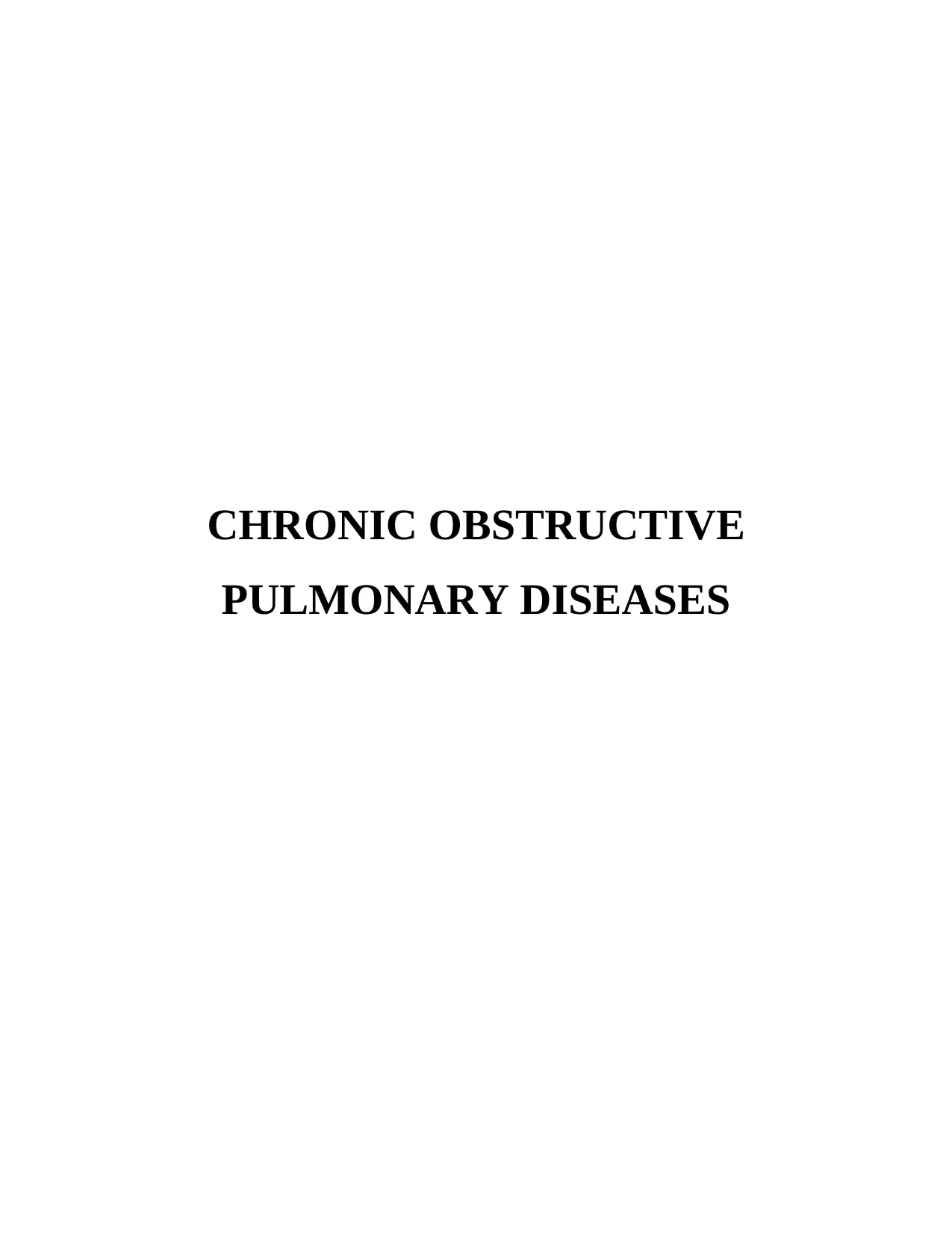
CHRONIC OBSTRUCTIVE
PULMONARY DISEASES
PULMONARY DISEASES
Secure Best Marks with AI Grader
Need help grading? Try our AI Grader for instant feedback on your assignments.
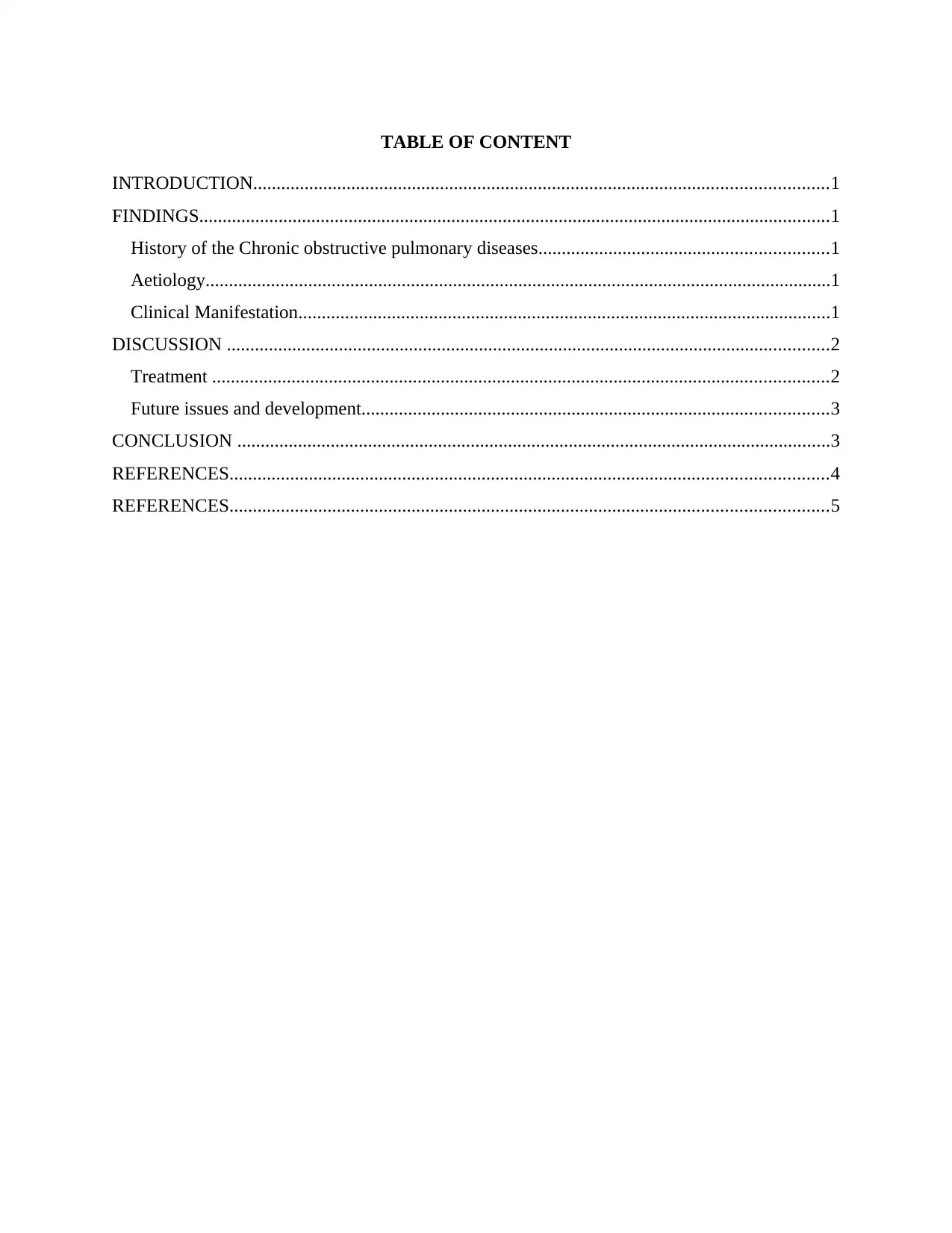
TABLE OF CONTENT
INTRODUCTION...........................................................................................................................1
FINDINGS.......................................................................................................................................1
History of the Chronic obstructive pulmonary diseases..............................................................1
Aetiology......................................................................................................................................1
Clinical Manifestation..................................................................................................................1
DISCUSSION .................................................................................................................................2
Treatment ....................................................................................................................................2
Future issues and development....................................................................................................3
CONCLUSION ...............................................................................................................................3
REFERENCES................................................................................................................................4
REFERENCES................................................................................................................................5
INTRODUCTION...........................................................................................................................1
FINDINGS.......................................................................................................................................1
History of the Chronic obstructive pulmonary diseases..............................................................1
Aetiology......................................................................................................................................1
Clinical Manifestation..................................................................................................................1
DISCUSSION .................................................................................................................................2
Treatment ....................................................................................................................................2
Future issues and development....................................................................................................3
CONCLUSION ...............................................................................................................................3
REFERENCES................................................................................................................................4
REFERENCES................................................................................................................................5
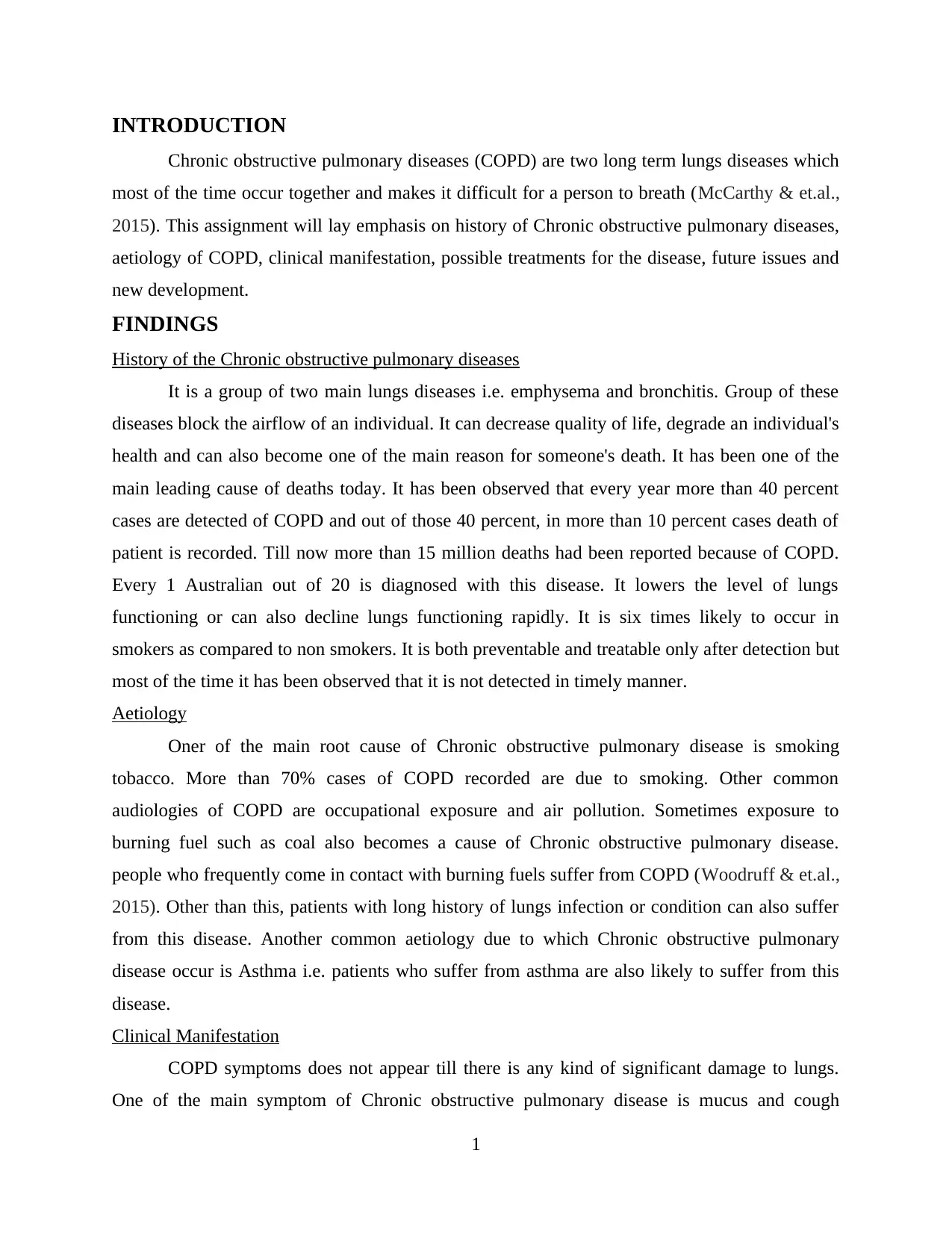
INTRODUCTION
Chronic obstructive pulmonary diseases (COPD) are two long term lungs diseases which
most of the time occur together and makes it difficult for a person to breath (McCarthy & et.al.,
2015). This assignment will lay emphasis on history of Chronic obstructive pulmonary diseases,
aetiology of COPD, clinical manifestation, possible treatments for the disease, future issues and
new development.
FINDINGS
History of the Chronic obstructive pulmonary diseases
It is a group of two main lungs diseases i.e. emphysema and bronchitis. Group of these
diseases block the airflow of an individual. It can decrease quality of life, degrade an individual's
health and can also become one of the main reason for someone's death. It has been one of the
main leading cause of deaths today. It has been observed that every year more than 40 percent
cases are detected of COPD and out of those 40 percent, in more than 10 percent cases death of
patient is recorded. Till now more than 15 million deaths had been reported because of COPD.
Every 1 Australian out of 20 is diagnosed with this disease. It lowers the level of lungs
functioning or can also decline lungs functioning rapidly. It is six times likely to occur in
smokers as compared to non smokers. It is both preventable and treatable only after detection but
most of the time it has been observed that it is not detected in timely manner.
Aetiology
Oner of the main root cause of Chronic obstructive pulmonary disease is smoking
tobacco. More than 70% cases of COPD recorded are due to smoking. Other common
audiologies of COPD are occupational exposure and air pollution. Sometimes exposure to
burning fuel such as coal also becomes a cause of Chronic obstructive pulmonary disease.
people who frequently come in contact with burning fuels suffer from COPD (Woodruff & et.al.,
2015). Other than this, patients with long history of lungs infection or condition can also suffer
from this disease. Another common aetiology due to which Chronic obstructive pulmonary
disease occur is Asthma i.e. patients who suffer from asthma are also likely to suffer from this
disease.
Clinical Manifestation
COPD symptoms does not appear till there is any kind of significant damage to lungs.
One of the main symptom of Chronic obstructive pulmonary disease is mucus and cough
1
Chronic obstructive pulmonary diseases (COPD) are two long term lungs diseases which
most of the time occur together and makes it difficult for a person to breath (McCarthy & et.al.,
2015). This assignment will lay emphasis on history of Chronic obstructive pulmonary diseases,
aetiology of COPD, clinical manifestation, possible treatments for the disease, future issues and
new development.
FINDINGS
History of the Chronic obstructive pulmonary diseases
It is a group of two main lungs diseases i.e. emphysema and bronchitis. Group of these
diseases block the airflow of an individual. It can decrease quality of life, degrade an individual's
health and can also become one of the main reason for someone's death. It has been one of the
main leading cause of deaths today. It has been observed that every year more than 40 percent
cases are detected of COPD and out of those 40 percent, in more than 10 percent cases death of
patient is recorded. Till now more than 15 million deaths had been reported because of COPD.
Every 1 Australian out of 20 is diagnosed with this disease. It lowers the level of lungs
functioning or can also decline lungs functioning rapidly. It is six times likely to occur in
smokers as compared to non smokers. It is both preventable and treatable only after detection but
most of the time it has been observed that it is not detected in timely manner.
Aetiology
Oner of the main root cause of Chronic obstructive pulmonary disease is smoking
tobacco. More than 70% cases of COPD recorded are due to smoking. Other common
audiologies of COPD are occupational exposure and air pollution. Sometimes exposure to
burning fuel such as coal also becomes a cause of Chronic obstructive pulmonary disease.
people who frequently come in contact with burning fuels suffer from COPD (Woodruff & et.al.,
2015). Other than this, patients with long history of lungs infection or condition can also suffer
from this disease. Another common aetiology due to which Chronic obstructive pulmonary
disease occur is Asthma i.e. patients who suffer from asthma are also likely to suffer from this
disease.
Clinical Manifestation
COPD symptoms does not appear till there is any kind of significant damage to lungs.
One of the main symptom of Chronic obstructive pulmonary disease is mucus and cough
1
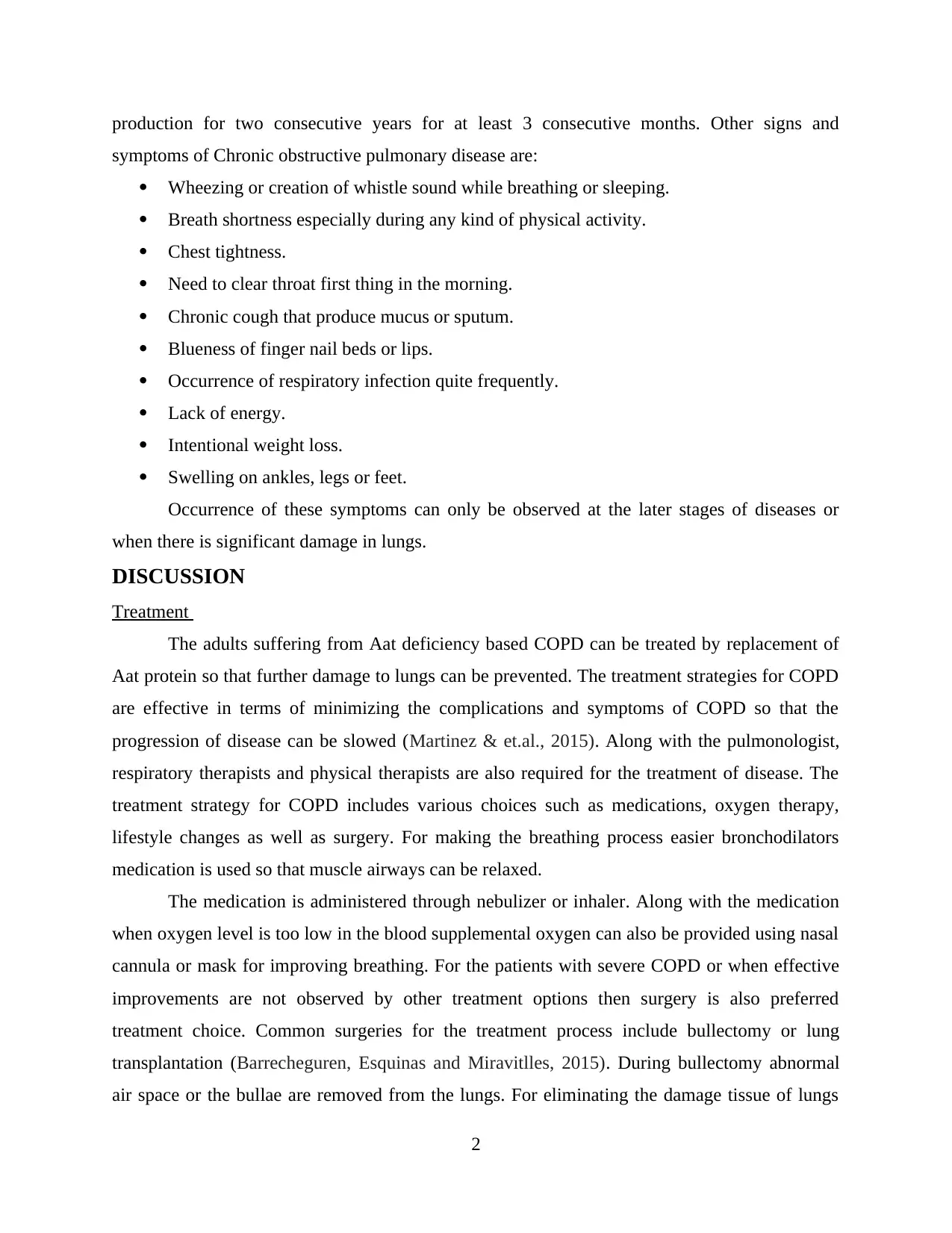
production for two consecutive years for at least 3 consecutive months. Other signs and
symptoms of Chronic obstructive pulmonary disease are:
Wheezing or creation of whistle sound while breathing or sleeping.
Breath shortness especially during any kind of physical activity.
Chest tightness.
Need to clear throat first thing in the morning.
Chronic cough that produce mucus or sputum.
Blueness of finger nail beds or lips.
Occurrence of respiratory infection quite frequently.
Lack of energy.
Intentional weight loss.
Swelling on ankles, legs or feet.
Occurrence of these symptoms can only be observed at the later stages of diseases or
when there is significant damage in lungs.
DISCUSSION
Treatment
The adults suffering from Aat deficiency based COPD can be treated by replacement of
Aat protein so that further damage to lungs can be prevented. The treatment strategies for COPD
are effective in terms of minimizing the complications and symptoms of COPD so that the
progression of disease can be slowed (Martinez & et.al., 2015). Along with the pulmonologist,
respiratory therapists and physical therapists are also required for the treatment of disease. The
treatment strategy for COPD includes various choices such as medications, oxygen therapy,
lifestyle changes as well as surgery. For making the breathing process easier bronchodilators
medication is used so that muscle airways can be relaxed.
The medication is administered through nebulizer or inhaler. Along with the medication
when oxygen level is too low in the blood supplemental oxygen can also be provided using nasal
cannula or mask for improving breathing. For the patients with severe COPD or when effective
improvements are not observed by other treatment options then surgery is also preferred
treatment choice. Common surgeries for the treatment process include bullectomy or lung
transplantation (Barrecheguren, Esquinas and Miravitlles, 2015). During bullectomy abnormal
air space or the bullae are removed from the lungs. For eliminating the damage tissue of lungs
2
symptoms of Chronic obstructive pulmonary disease are:
Wheezing or creation of whistle sound while breathing or sleeping.
Breath shortness especially during any kind of physical activity.
Chest tightness.
Need to clear throat first thing in the morning.
Chronic cough that produce mucus or sputum.
Blueness of finger nail beds or lips.
Occurrence of respiratory infection quite frequently.
Lack of energy.
Intentional weight loss.
Swelling on ankles, legs or feet.
Occurrence of these symptoms can only be observed at the later stages of diseases or
when there is significant damage in lungs.
DISCUSSION
Treatment
The adults suffering from Aat deficiency based COPD can be treated by replacement of
Aat protein so that further damage to lungs can be prevented. The treatment strategies for COPD
are effective in terms of minimizing the complications and symptoms of COPD so that the
progression of disease can be slowed (Martinez & et.al., 2015). Along with the pulmonologist,
respiratory therapists and physical therapists are also required for the treatment of disease. The
treatment strategy for COPD includes various choices such as medications, oxygen therapy,
lifestyle changes as well as surgery. For making the breathing process easier bronchodilators
medication is used so that muscle airways can be relaxed.
The medication is administered through nebulizer or inhaler. Along with the medication
when oxygen level is too low in the blood supplemental oxygen can also be provided using nasal
cannula or mask for improving breathing. For the patients with severe COPD or when effective
improvements are not observed by other treatment options then surgery is also preferred
treatment choice. Common surgeries for the treatment process include bullectomy or lung
transplantation (Barrecheguren, Esquinas and Miravitlles, 2015). During bullectomy abnormal
air space or the bullae are removed from the lungs. For eliminating the damage tissue of lungs
2
Secure Best Marks with AI Grader
Need help grading? Try our AI Grader for instant feedback on your assignments.
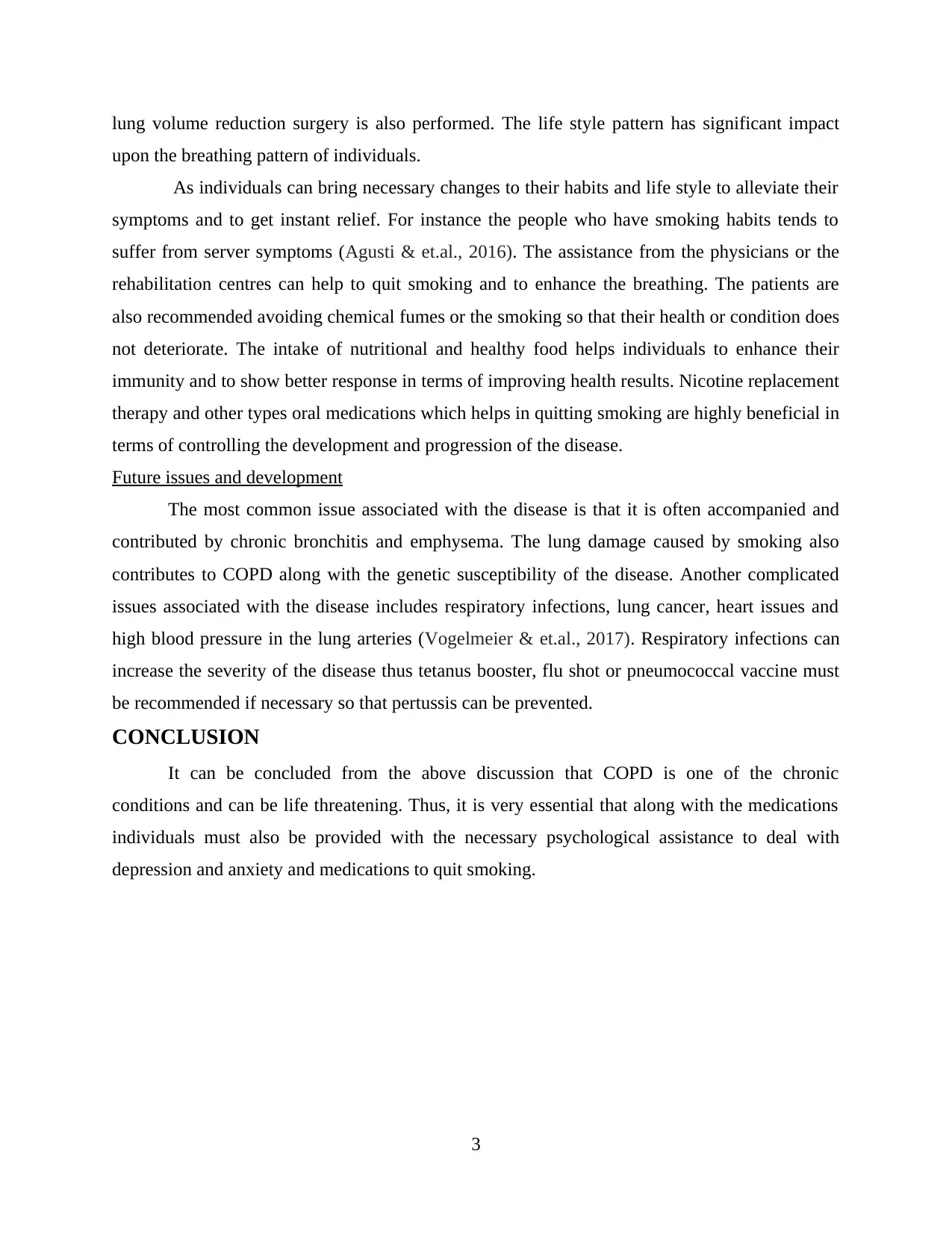
lung volume reduction surgery is also performed. The life style pattern has significant impact
upon the breathing pattern of individuals.
As individuals can bring necessary changes to their habits and life style to alleviate their
symptoms and to get instant relief. For instance the people who have smoking habits tends to
suffer from server symptoms (Agusti & et.al., 2016). The assistance from the physicians or the
rehabilitation centres can help to quit smoking and to enhance the breathing. The patients are
also recommended avoiding chemical fumes or the smoking so that their health or condition does
not deteriorate. The intake of nutritional and healthy food helps individuals to enhance their
immunity and to show better response in terms of improving health results. Nicotine replacement
therapy and other types oral medications which helps in quitting smoking are highly beneficial in
terms of controlling the development and progression of the disease.
Future issues and development
The most common issue associated with the disease is that it is often accompanied and
contributed by chronic bronchitis and emphysema. The lung damage caused by smoking also
contributes to COPD along with the genetic susceptibility of the disease. Another complicated
issues associated with the disease includes respiratory infections, lung cancer, heart issues and
high blood pressure in the lung arteries (Vogelmeier & et.al., 2017). Respiratory infections can
increase the severity of the disease thus tetanus booster, flu shot or pneumococcal vaccine must
be recommended if necessary so that pertussis can be prevented.
CONCLUSION
It can be concluded from the above discussion that COPD is one of the chronic
conditions and can be life threatening. Thus, it is very essential that along with the medications
individuals must also be provided with the necessary psychological assistance to deal with
depression and anxiety and medications to quit smoking.
3
upon the breathing pattern of individuals.
As individuals can bring necessary changes to their habits and life style to alleviate their
symptoms and to get instant relief. For instance the people who have smoking habits tends to
suffer from server symptoms (Agusti & et.al., 2016). The assistance from the physicians or the
rehabilitation centres can help to quit smoking and to enhance the breathing. The patients are
also recommended avoiding chemical fumes or the smoking so that their health or condition does
not deteriorate. The intake of nutritional and healthy food helps individuals to enhance their
immunity and to show better response in terms of improving health results. Nicotine replacement
therapy and other types oral medications which helps in quitting smoking are highly beneficial in
terms of controlling the development and progression of the disease.
Future issues and development
The most common issue associated with the disease is that it is often accompanied and
contributed by chronic bronchitis and emphysema. The lung damage caused by smoking also
contributes to COPD along with the genetic susceptibility of the disease. Another complicated
issues associated with the disease includes respiratory infections, lung cancer, heart issues and
high blood pressure in the lung arteries (Vogelmeier & et.al., 2017). Respiratory infections can
increase the severity of the disease thus tetanus booster, flu shot or pneumococcal vaccine must
be recommended if necessary so that pertussis can be prevented.
CONCLUSION
It can be concluded from the above discussion that COPD is one of the chronic
conditions and can be life threatening. Thus, it is very essential that along with the medications
individuals must also be provided with the necessary psychological assistance to deal with
depression and anxiety and medications to quit smoking.
3
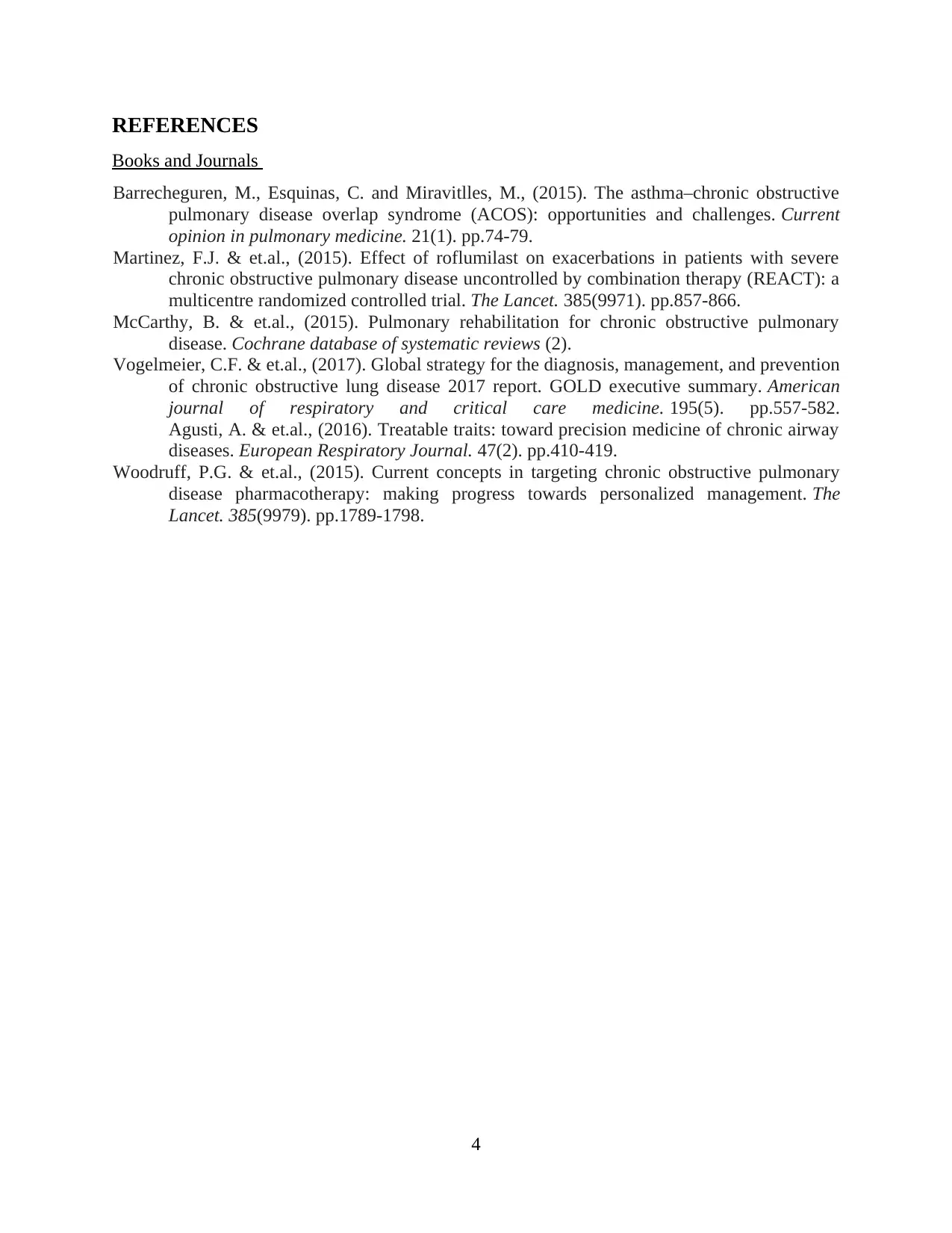
REFERENCES
Books and Journals
Barrecheguren, M., Esquinas, C. and Miravitlles, M., (2015). The asthma–chronic obstructive
pulmonary disease overlap syndrome (ACOS): opportunities and challenges. Current
opinion in pulmonary medicine. 21(1). pp.74-79.
Martinez, F.J. & et.al., (2015). Effect of roflumilast on exacerbations in patients with severe
chronic obstructive pulmonary disease uncontrolled by combination therapy (REACT): a
multicentre randomized controlled trial. The Lancet. 385(9971). pp.857-866.
McCarthy, B. & et.al., (2015). Pulmonary rehabilitation for chronic obstructive pulmonary
disease. Cochrane database of systematic reviews (2).
Vogelmeier, C.F. & et.al., (2017). Global strategy for the diagnosis, management, and prevention
of chronic obstructive lung disease 2017 report. GOLD executive summary. American
journal of respiratory and critical care medicine. 195(5). pp.557-582.
Agusti, A. & et.al., (2016). Treatable traits: toward precision medicine of chronic airway
diseases. European Respiratory Journal. 47(2). pp.410-419.
Woodruff, P.G. & et.al., (2015). Current concepts in targeting chronic obstructive pulmonary
disease pharmacotherapy: making progress towards personalized management. The
Lancet. 385(9979). pp.1789-1798.
4
Books and Journals
Barrecheguren, M., Esquinas, C. and Miravitlles, M., (2015). The asthma–chronic obstructive
pulmonary disease overlap syndrome (ACOS): opportunities and challenges. Current
opinion in pulmonary medicine. 21(1). pp.74-79.
Martinez, F.J. & et.al., (2015). Effect of roflumilast on exacerbations in patients with severe
chronic obstructive pulmonary disease uncontrolled by combination therapy (REACT): a
multicentre randomized controlled trial. The Lancet. 385(9971). pp.857-866.
McCarthy, B. & et.al., (2015). Pulmonary rehabilitation for chronic obstructive pulmonary
disease. Cochrane database of systematic reviews (2).
Vogelmeier, C.F. & et.al., (2017). Global strategy for the diagnosis, management, and prevention
of chronic obstructive lung disease 2017 report. GOLD executive summary. American
journal of respiratory and critical care medicine. 195(5). pp.557-582.
Agusti, A. & et.al., (2016). Treatable traits: toward precision medicine of chronic airway
diseases. European Respiratory Journal. 47(2). pp.410-419.
Woodruff, P.G. & et.al., (2015). Current concepts in targeting chronic obstructive pulmonary
disease pharmacotherapy: making progress towards personalized management. The
Lancet. 385(9979). pp.1789-1798.
4

REFERENCES
Books and journals
5
Books and journals
5
1 out of 7
Related Documents
Your All-in-One AI-Powered Toolkit for Academic Success.
+13062052269
info@desklib.com
Available 24*7 on WhatsApp / Email
![[object Object]](/_next/static/media/star-bottom.7253800d.svg)
Unlock your academic potential
© 2024 | Zucol Services PVT LTD | All rights reserved.



